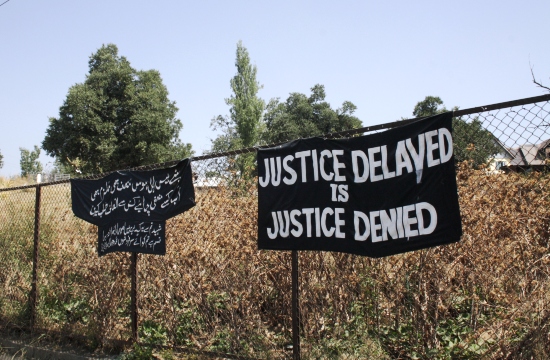
[stextbox id=”info”]By: PARVAIZ BUKHARI[/stextbox]
The culprits of double rape and murder in Shopian may be criminals in uniform, but the series of damning official cover-ups so far highlight that Kashmir is a function of ‘military-security’ control. Does CBI have the autonomy to indict the system? Whatever the results, the CBI findings cannot escape being just another statement in the twisted political history and saga of an ever rebelling Kashmir.
Last Monday was perhaps the most painful day in living memory for the people of Shopian. Amid tight security and a spread of concertina razor wire coils across all main roads, people remained in pensive calm as a special team of forensic experts from New Delhi’s All India Institute of Medical Sciences (AIIMS), accompanying CBI sleuths, started exhuming the bodies of sisters-in-law Neelofar Jan and teenaged Asiya. They had been buried for four months since their family and locals alleged that ‘security forces’ personnel abducted, raped and then murdered them.
Women who had assembled in a show of solidarity around the victims’ family house sobbed and wailed with pain as the process of exhumation went on for ten long hours. Oblivious in his innocence, Neelofar’s four-year-old son was playing around smiling while the town relived the pain of his mother’s brutal killing. But it was hard to understand the calm observed by the same people whose rage has kept the police away from the streets of Shopian since the incident – and who only on appeals and assurances of justice from the state High Court reluctantly ended a 47-day-long protest shutdown demanding justice for the victims’ family.
Does the calm denote any degree of public satisfaction with the ongoing investigation by India’s premier investigating agency? Is there an expectation of justice from an organization whose ‘autonomy’ has often been questioned as a tool in the hands of establishment in New Delhi? Conversations with people, who had gathered around the graveyard as security restrictions eased and the calm appeared stable, reveal otherwise.
“By handing over the case to CBI, that is making the whole investigation about molecular science, our voice has once again been taken away from us,” said Shabir Shafi, a graduate student. “All we are expected to do now is to accept the findings. In Kashmir I don’t expect a state agency to be impartial if state forces are perpetrators of a crime.”
In an overall atmosphere of extreme scepticism numerous onlookers echoed the same helplessness about their disability to keep under check and question the ongoing investigation anymore. It was only under sustained public pressure that government registered separate cases of murder and rape more than a week after discovery of the victims’ bodies. Growing public awareness of officially obfuscating crimes committed in the past by central forces, including army and CRPF deployed in Kashmir in their hundreds of thousands, cover-up after cover-up was exposed. In the course the stakes in revealing the truth about the Shopian incident became hugely political in a disputed territory that India refuses to officially acknowledge as a military occupation.
Kashmir has long been a place where the political is sought to be depoliticized and vice versa in the so called mainstream discourse. Many politically aware and educated residents of Shopian fear that the CBI investigation may do a big Asrar Dar on the people of Kashmir again. They believe in their cumulative understanding of events here that Asrar Dar of Maisuma may have been killed with indirect official incitement and promises of a never ending police probe to discredit public resentment of the security apparatus as unfounded, habitual or paid. Young student Dar’s killing, earlier suspected to be carried out by personnel of police or other armed forces triggered another wave of angry anti-India protests in the aftermath of Shopian, was closed as a solved case of a crime in a love triangle.
With the exhumations in Shopian, the CBI has started the investigation afresh. But timed information leaks to selective media outlets about what the investigators may have found from the victims’ bodies looked like timed rumours that kept appearing in media in the course of the failed police investigation into the incident. Some of the earlier rumours and leaks even found their way into the Justice (Rtd) Jan Commission report as well, that suspected even the victims and their families as conniving partners in the crime.
The course of investigation, including the ongoing one by CBI,















